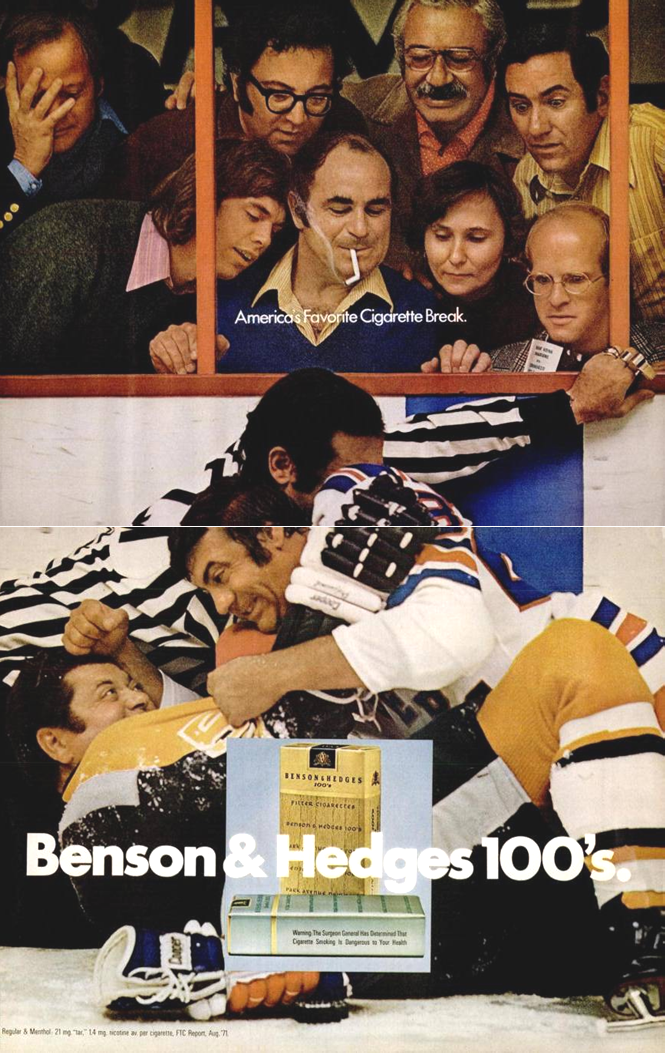“As a smoker, you smoke a lot of cigarettes when you feel fear…So, when I tell you that smoking is bad, that you can get cancer from it…that you are killing yourself, most likely you’ll become afraid and you’ll want a cigarette.” - Eric Eraly
The practice of placing hidden (subliminal) words in select print advertisements is a technique used by advertisers. Advertisers know that most people will not spend much time looking at print advertisements. Therefore, hidden (subliminal) ideas, imagery, and words can be placed in print advertisements without immediate detection.
The Dark Side of Subliminal Advertising is a blog site that exposes the advertising technique of placing hidden (subliminal) ideas, imagery, and words in advertisements.
It is important to realize that ads are not designed for the conscious mind, they are deliberately designed to reach the subconscious mind. The subconscious mind operates under a different set of laws compared to the operations of the conscious mind.
On average, people look at a print ad for no more than two seconds. Therefore the advertiser has two seconds in which to convey a message in order to increase sales.
With this in mind, look closely at this advertisement and see if you notice anything interesting:



The word on this glove is slightly distorted. But, when analyzed carefully, the word is not "Cooper", it is clearly the word "Cancer":

The smoker behind the safety glass is on the outside looking in. This smoker is viewing an internal struggle, within himself, between good health and cancer (which is represented by the two hockey players fighting). The people surrounding the man are family and friends who are concerned about the outcome of the smoker's internal battle.
Take notice that the hockey player on the top of the other player has his gloves off. The glove with the word "Cancer" on it is one of this hockey player's gloves. This glove is blue.
“When the gloves come off” is an idiom that means that a civilized boxing match is going to become a bare knuckled fist fight which could soon turn ugly.
The hockey player that is on top of the other hockey player represents "CANCER". Currently, this player has the advantage in this fight.
At the moment, the hockey player on the bottom is still wearing his gloves which will not cause as much damage as if he had his gloves off.
The hockey player that is on bottom of the other hockey player represents "GOOD HEALTH". Currently, this player has the disadvantage in this fight.
Only time will tell who the winner of the fight will be for the smoker behind the safety glass.
ANXIETY AND FEAR:
This print ad has been deliberately created to tap into the subconscious anxiety and fear of the target audience concerning the threat of cancer.
With concern over the fear of cancer, stress management expert Sally Wilson states:
“All fear will create a degree of anxiety. Conscious fears can be relatively easy to dissolve through reasoning. Other fears can deeply affect our subconscious attitudes and affect our mental health with the power to disturb our peace of mind. We may not even be aware of them. But they will all contribute to any anxiety state we may suffer."1
According to authors Thomas O'Guinn, Chris Allen, and Richard J. Semenik:
1. “People try to avoid feeling anxious. They try to minimize, moderate, and alleviate anxiety.”2
2. “Often people will buy or consume things to help them in their continuing struggle with anxiety.” 3
3. “Advertisers realize this and use many settings to demonstrate why you should be anxious and what you can do to alleviate the anxiety.” 4
4. “Advertisers pursue a change behavior-by-inducing-anxiety objective by playing on consumer anxieties. The ads work through both thought and feelings.” 5
In a recent study on the struggle to quit smoking, it was noticed that anxiety diagnoses were very common among the participants of the study. This study suggests that smokers who have been diagnosed with anxiety disorders had lower quitting rates when compared with smokers who have not been diagnosed with anxiety. 6
Research has revealed that up to 25%, of the more than 50 million smokers in the United States, have had at least one anxiety disorder in their lifetime. 7
SURGEON GENERAL WARNING:
Notice that the glove, with the word "Cancer" on it, appears right next to the Surgeon General's warning about cigarette smoking:

The practice of placing hidden (subliminal) words in select print advertisements is a technique used by advertisers. Advertisers know that most people will not spend much time looking at print advertisements. Therefore, hidden (subliminal) ideas, imagery, and words can be placed in print advertisements without immediate detection.
The Dark Side of Subliminal Advertising is a blog site that exposes the advertising technique of placing hidden (subliminal) ideas, imagery, and words in advertisements.
It is important to realize that ads are not designed for the conscious mind, they are deliberately designed to reach the subconscious mind. The subconscious mind operates under a different set of laws compared to the operations of the conscious mind.
On average, people look at a print ad for no more than two seconds. Therefore the advertiser has two seconds in which to convey a message in order to increase sales.
With this in mind, look closely at this advertisement and see if you notice anything interesting:
Look very carefully at the gloves. The gloves were made by Cooper Canada Ltd, a manufacturer of ice hockey equipment.
The glove on the left clearly shows the name "Cooper" on it. However, look closely at the lettering on the right glove:
Notice that the next letter to the right of the first letter "C” is not an "o", like it is supposed to be in the name “Cooper.” This next letter is the letter “a.” Where is the letter "p" in the brand name "Cooper" on this glove? There is no letter “p”, but there is a letter "c" where the letter "p" should be. Also, the letter "n" runs alongside the second letter "c".
The word on this glove is slightly distorted. But, when analyzed carefully, the word is not "Cooper", it is clearly the word "Cancer":
The smoker behind the safety glass is on the outside looking in. This smoker is viewing an internal struggle, within himself, between good health and cancer (which is represented by the two hockey players fighting). The people surrounding the man are family and friends who are concerned about the outcome of the smoker's internal battle.
Take notice that the hockey player on the top of the other player has his gloves off. The glove with the word "Cancer" on it is one of this hockey player's gloves. This glove is blue.
“When the gloves come off” is an idiom that means that a civilized boxing match is going to become a bare knuckled fist fight which could soon turn ugly.
The hockey player that is on top of the other hockey player represents "CANCER". Currently, this player has the advantage in this fight.
At the moment, the hockey player on the bottom is still wearing his gloves which will not cause as much damage as if he had his gloves off.
The hockey player that is on bottom of the other hockey player represents "GOOD HEALTH". Currently, this player has the disadvantage in this fight.
Only time will tell who the winner of the fight will be for the smoker behind the safety glass.
ANXIETY AND FEAR:
This print ad has been deliberately created to tap into the subconscious anxiety and fear of the target audience concerning the threat of cancer.
With concern over the fear of cancer, stress management expert Sally Wilson states:
“All fear will create a degree of anxiety. Conscious fears can be relatively easy to dissolve through reasoning. Other fears can deeply affect our subconscious attitudes and affect our mental health with the power to disturb our peace of mind. We may not even be aware of them. But they will all contribute to any anxiety state we may suffer."1
According to authors Thomas O'Guinn, Chris Allen, and Richard J. Semenik:
1. “People try to avoid feeling anxious. They try to minimize, moderate, and alleviate anxiety.”2
2. “Often people will buy or consume things to help them in their continuing struggle with anxiety.” 3
3. “Advertisers realize this and use many settings to demonstrate why you should be anxious and what you can do to alleviate the anxiety.” 4
4. “Advertisers pursue a change behavior-by-inducing-anxiety objective by playing on consumer anxieties. The ads work through both thought and feelings.” 5
In a recent study on the struggle to quit smoking, it was noticed that anxiety diagnoses were very common among the participants of the study. This study suggests that smokers who have been diagnosed with anxiety disorders had lower quitting rates when compared with smokers who have not been diagnosed with anxiety. 6
Research has revealed that up to 25%, of the more than 50 million smokers in the United States, have had at least one anxiety disorder in their lifetime. 7
SURGEON GENERAL WARNING:
Notice that the glove, with the word "Cancer" on it, appears right next to the Surgeon General's warning about cigarette smoking:
Why would the advertiser place the word “Cancer” right next to the Surgeon General’s warning in this cigarette advertisement?
In order to answer this question, consider the following two studies:
UNIVERSITY OF BASEL STUDY ON WARNING LABELS:
A study, led by Jochim Hansen of New York University and the University of Basel, was conducted pertaining to the effectiveness of warnings on cigarette labels. Here are some of the results of this study:
"Among the students for whom smoking was important to their self-esteem, those who looked at packets with death-related warnings subsequently reported more positive attitudes to smoking compared with those who looked at death-neutral packets.” 8
“In other words, for smokers who derive a self-esteem boost from smoking, a death-related cigarette packet warning can have the ironic effect of making them want to smoke more, so as to buffer themselves against the depressing reminder of their own mortality.” 9
The study showed “that cigarette packets with death-related warnings were not effective and even caused more positive smoking attitudes.” 10
The researchers concluded “that considering death may make some people smoke.” 11
NEUROMARKETING STUDY ON WARNING LABELS:
Recently, the largest neuromarketing experiment in history was conducted using two of the most sophisticated brain-scanning instruments in the world: fMRI (Functional magnetic resonance imaging) and SST (steady-state topography-an advanced version of the electroencephalograph).
This study was funded by eight multinational companies and cost around $7 million.
Dr. Gemma Calvert, the leader of the research team for the large neuromarketing experiment, discovered the following:
1. “Cigarette warnings—whether they informed smokers they were at risk of contracting emphysema, heart disease, or a host of other chronic conditions—had in fact stimulated an area of the smoker’s brain called the nucleus accumbens, otherwise known as “the craving spot." This region is a chain-link of specialized neurons that lights up when the body desires something.” 12
2. “In short, the fMRI results showed that cigarette warning labels not only failed to deter smoking, but by activating the nucleus accumbens, it appeared they actually encouraged smokers to light up.” 13
This explains why approximately 15 billion cigarettes are sold daily “despite worldwide tobacco advertising bans, outspoken and frequent health warnings from the medical community, and massive government investment in antismoking campaigns.” 14
THE WORLD HEALTH ORGANIZATION AND WARNING LABELS:
The World Health Organization (WHO) promotes the use of tobacco health warnings to warn people about the harmful effects of tobacco use.
“Article 11 of the WHO Framework Convention on Tobacco Control (WHO FCTC) requires Parties to the Convention to implement large, rotating health warnings on all tobacco product packaging and labeling. Pictorial health warnings on tobacco packages are a cost-effective means to increase public awareness about the dangers of tobacco use. Guidelines for Article 11 of the WHO FCTC recommend that Parties should mandate full colour pictures or pictograms, in their packaging and labeling requirements.” 15
According to the WHO Report on the Global Tobacco Epidemic:
“The data are impressive. More than 1 billion people now live in countries with legislation that required large graphic health warnings on every cigarette pack sold in their countries…Nevertheless, the tobacco epidemic continues to expand because of ongoing tobacco industry marketing, population growth in countires where tobacco use is increasing, and the extreme addictiveness of tobacco that makes it difficult for people to stop smoking once they start.” 16
As previously mentioned, studies are showing that cigarette packets with death-related warnings are not effective and even cause more positive smoking attitudes.
Therefore, the WHO worldwide implementation of warning labels on tobacco packaging will actually help spread the very global tobacco epidemic that they are working to eliminate.
CONCLUSION:
In the above advertisement, the fear of cancer is presented, on a subliminal level, in order to create anxiety so that the smoker will want to smoke more cigarettes. The smoker smokes more cigarettes in order to relieve this anxiety. This cycle is repeated continuously by the consumer as the sales of cigarettes increase.
Smoking is a leading cause of cancer and death from cancer. It causes cancers of the lung, esophagus, larynx, mouth, throat, kidney, bladder, pancreas, stomach, and cervix, as well as acute myeloid leukemia. 17
Of the more than 7,000 chemicals in tobacco smoke, at least 250 are known to be harmful. Among the 250 known harmful chemicals in tobacco smoke, at least 68 can cause cancer. 18
Cigarette smoking and exposure to tobacco smoke cause more than 440,000 premature deaths each year in the United States. Of these premature deaths, about 40 percent are from cancer. 19
In order to answer this question, consider the following two studies:
UNIVERSITY OF BASEL STUDY ON WARNING LABELS:
A study, led by Jochim Hansen of New York University and the University of Basel, was conducted pertaining to the effectiveness of warnings on cigarette labels. Here are some of the results of this study:
"Among the students for whom smoking was important to their self-esteem, those who looked at packets with death-related warnings subsequently reported more positive attitudes to smoking compared with those who looked at death-neutral packets.” 8
“In other words, for smokers who derive a self-esteem boost from smoking, a death-related cigarette packet warning can have the ironic effect of making them want to smoke more, so as to buffer themselves against the depressing reminder of their own mortality.” 9
The study showed “that cigarette packets with death-related warnings were not effective and even caused more positive smoking attitudes.” 10
The researchers concluded “that considering death may make some people smoke.” 11
NEUROMARKETING STUDY ON WARNING LABELS:
Recently, the largest neuromarketing experiment in history was conducted using two of the most sophisticated brain-scanning instruments in the world: fMRI (Functional magnetic resonance imaging) and SST (steady-state topography-an advanced version of the electroencephalograph).
This study was funded by eight multinational companies and cost around $7 million.
Dr. Gemma Calvert, the leader of the research team for the large neuromarketing experiment, discovered the following:
1. “Cigarette warnings—whether they informed smokers they were at risk of contracting emphysema, heart disease, or a host of other chronic conditions—had in fact stimulated an area of the smoker’s brain called the nucleus accumbens, otherwise known as “the craving spot." This region is a chain-link of specialized neurons that lights up when the body desires something.” 12
2. “In short, the fMRI results showed that cigarette warning labels not only failed to deter smoking, but by activating the nucleus accumbens, it appeared they actually encouraged smokers to light up.” 13
This explains why approximately 15 billion cigarettes are sold daily “despite worldwide tobacco advertising bans, outspoken and frequent health warnings from the medical community, and massive government investment in antismoking campaigns.” 14
THE WORLD HEALTH ORGANIZATION AND WARNING LABELS:
The World Health Organization (WHO) promotes the use of tobacco health warnings to warn people about the harmful effects of tobacco use.
“Article 11 of the WHO Framework Convention on Tobacco Control (WHO FCTC) requires Parties to the Convention to implement large, rotating health warnings on all tobacco product packaging and labeling. Pictorial health warnings on tobacco packages are a cost-effective means to increase public awareness about the dangers of tobacco use. Guidelines for Article 11 of the WHO FCTC recommend that Parties should mandate full colour pictures or pictograms, in their packaging and labeling requirements.” 15
According to the WHO Report on the Global Tobacco Epidemic:
“The data are impressive. More than 1 billion people now live in countries with legislation that required large graphic health warnings on every cigarette pack sold in their countries…Nevertheless, the tobacco epidemic continues to expand because of ongoing tobacco industry marketing, population growth in countires where tobacco use is increasing, and the extreme addictiveness of tobacco that makes it difficult for people to stop smoking once they start.” 16
As previously mentioned, studies are showing that cigarette packets with death-related warnings are not effective and even cause more positive smoking attitudes.
Therefore, the WHO worldwide implementation of warning labels on tobacco packaging will actually help spread the very global tobacco epidemic that they are working to eliminate.
CONCLUSION:
In the above advertisement, the fear of cancer is presented, on a subliminal level, in order to create anxiety so that the smoker will want to smoke more cigarettes. The smoker smokes more cigarettes in order to relieve this anxiety. This cycle is repeated continuously by the consumer as the sales of cigarettes increase.
Smoking is a leading cause of cancer and death from cancer. It causes cancers of the lung, esophagus, larynx, mouth, throat, kidney, bladder, pancreas, stomach, and cervix, as well as acute myeloid leukemia. 17
Of the more than 7,000 chemicals in tobacco smoke, at least 250 are known to be harmful. Among the 250 known harmful chemicals in tobacco smoke, at least 68 can cause cancer. 18
Cigarette smoking and exposure to tobacco smoke cause more than 440,000 premature deaths each year in the United States. Of these premature deaths, about 40 percent are from cancer. 19